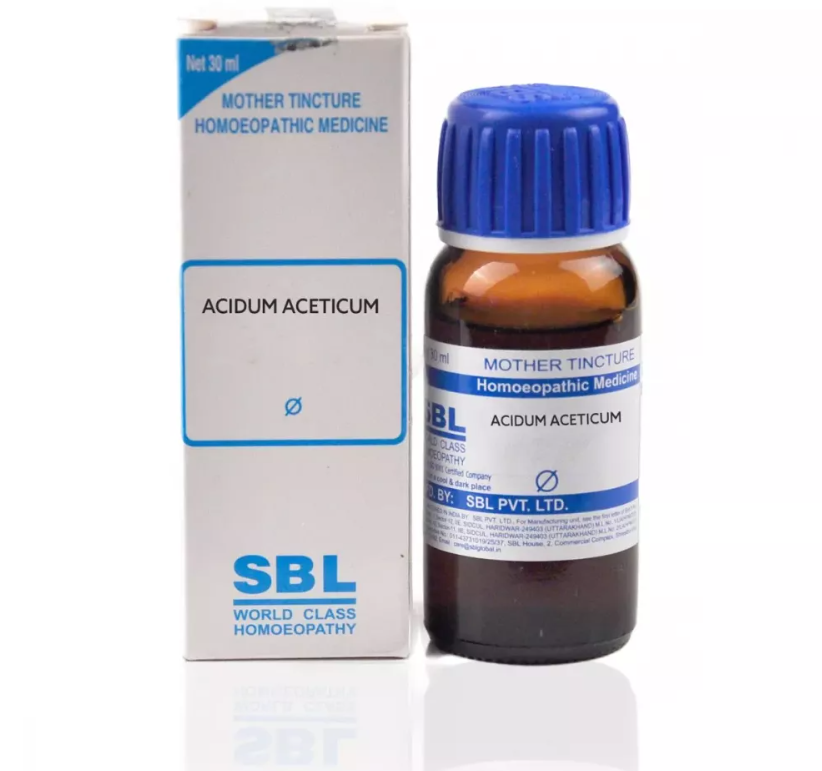ACETICUM ACIDUM Q, 6C, 12C, 30C, 200C, 1M, 10M USES AND SYMPTOMS
 ACETICUM ACIDUM (Glacial Acetic Acid)
ACETICUM ACIDUM (Glacial Acetic Acid)
Common Name: Glacial Acetic Acid
Abbreviation: Acet-ac.
Keynotes:
- Profound anemia with dropsy, great debility, frequent fainting, dyspnea, weak heart, vomiting, profuse micturition, and sweat.
- Hemorrhage from any part.
- Especially indicated in pale, lean people with lax, flabby muscles.
- Has the power to liquify albuminous and fibrinous deposits.
- Useful in epithelial cancer, internally and locally.
- Softens and causes the formation of pus in the 1x solution.
Mind:
- Irritable, worried about business affairs.
Head:
- Nervous headache from abuse of narcotics.
- Blood rushes to the head with delirium.
- Temporal vessels distended.
- Pain across the root of the tongue.
Face:
- Pale, waxy, emaciated appearance.
- Sunken eyes surrounded by dark rings.
- Bright red face.
- Sweaty.
- Epithelioma of lips.
- Cheeks hot and flushed.
- Aching in the left temporo-mandibular joint.
Stomach:
- Salivation.
- Fermentation in the stomach.
- Intense burning thirst.
- Cold drinks distress.
- Vomiting after every kind of food.
- Epigastric tenderness.
- Burning pain, as of an ulcer.
- Cancer of the stomach.
- Sour belching and vomiting.
- Burning waterbrash and profuse salivation.
- Hyperchlorhydria and gastralgia.
- Violent burning pains in the stomach and chest followed by coldness of the skin and cold sweat on the forehead.
- Stomach feels as if consumed a lot of vinegar.
Abdomen:
- Sensation as if the abdomen was sinking.
- Frequent watery stools, worse in the morning.
- Tympanitic abdomen.
- Ascites.
- Hemorrhage from bowels.
Urinary:
- Large quantities of pale urine.
- Diabetes with great thirst and debility (Ph-ac.).
Female:
- Excessive catamenia.
- Hemorrhages after labor.
- Nausea of pregnancy.
- Painfully enlarged breasts (mastitis), distended with milk.
- Impoverished, bluish, transparent, sour milk.
- Anemia in nursing mothers.
Respiratory:
- Hoarse, hissing respiration; difficulty in breathing; cough when inhaling.
- Membranous croup.
- Irritation of trachea and bronchial tubes.
- False membrane in the throat (diphtheria).
- Profuse bronchorrhea.
- Fibrinous exudation in the throat (gargle).
Back:
- Pain in the back, relieved only by lying on the abdomen.
Extremities:
- Emaciation.
- Edema of feet and legs.
Fever:
- Hectic fever with drenching night sweats.
- Hyperemic spot on the left cheek.
- No thirst during fever.
- Ebullitions.
- Profuse, cold sweat.
Skin:
- Pale, waxy, edematous appearance.
- Burning, dry, hot skin, or bathed in profuse sweat.
- Decreased sensations on the body surface.
- Useful after stings, bites, etc.
- Varicose swellings.
- Scurvy; anasarca.
- Bruises; sprains.
Relationship:
- Acet-ac. is antidotal to all anesthetic vapors.
- Counteracts sausage poisoning.
- Compare with Ammonium aceticum (abundant saccharine in urine, patient is bathed in sweat), Benzoin oderiferum-Spice wood (night sweats), Ars., Chin., Dig., Liat. (general anasarca in heart and kidney disease, dropsy, and chronic diarrhea).
Dose:
- Not to be repeated too often, except in croup.

selection of the potency
Individualization:
- Homeopathy is based on the principle of treating the individual, not just the disease. The unique symptoms and characteristics of the person are crucial in determining the most suitable potency.
Intensity of Symptoms:
- The intensity of the symptoms guides the choice of potency. If the symptoms are intense and acute, a lower potency (e.g., 6C, 30C) might be considered. For chronic conditions with less intensity, higher potencies (e.g., 200C, 1M) may be appropriate.
Sensitivity of the Patient:
- Some individuals are more sensitive to homeopathic remedies, while others may require higher potencies. The practitioner considers the patient’s sensitivity when selecting the potency.
Acute vs. Chronic Conditions:
- Lower potencies are often used for acute conditions, while higher potencies may be considered for chronic or long-standing issues.
Previous Response to Potencies:
- The patient’s response to previous homeopathic treatments helps guide the choice of potency. If a particular potency has been effective in the past, it may be repeated or adjusted as needed.
Vital Force and Susceptibility:
- Homeopathy views illness as a disturbance in the vital force. The practitioner assesses the patient’s overall vitality and susceptibility to determine the appropriate potency.
Aggravation or Amelioration:
- The direction of the symptom response (aggravation or amelioration) after taking a remedy can influence the choice of potency.
Miasmatic Considerations:
- In classical homeopathy, the concept of miasms (inherited disease tendencies) is considered. The practitioner take this into account when selecting the potency.
Practitioner Experience:
- The experience and preference of the homeopathic practitioner play a role. Some practitioners may have success with certain potencies based on their clinical experience.
SAFETY INFORMATION
- Do not exceed the recommended dose by physician
- Keep out of the reach of children
- Store in a cool dry place away from direct sunlight
- Maintain half an hour gap between food/drink/any other medicines and homoeopathic medicine
- Avoid any strong smell in the mouth while taking medicine e.g. camphor, garlic, onion, coffee, hing
Medicine images use for reference only selection of homeopathic medicine depends on the individual’s specific symptoms and overall constitution. Moreover, homeopathy is a holistic system of medicine that treats the individual as a whole. In addition to addressing the physical symptoms, it takes into account the emotional and mental state of the person. Consequently, it’s crucial to consult with a qualified homeopathic practitioner for personalized treatment.
The information provided on this website is intended solely for educational purposes. Always seek the advice of your physician or other qualified health provider.
